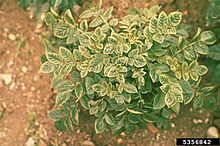Potato leafroll virus
| Potato leafroll virus | |
|---|---|
 |
|
| A potato plant infected with Potato leafroll virus | |
| Virus classification | |
| Group: | Group IV ((+)ssRNA) |
| Family: | Luteoviridae |
| Genus: | Polerovirus |
Potato leafroll virus (PLRV) is a member of the genus Polerovirus and family Luteoviridae. The phloem limited positive sense RNA virus infects potatoes and other members of the family Solanaceae. PLRV was first described by Quanjer et al. in 1916. PLRV is transmitted by aphids, primarily the green peach aphid, Myzus persicae. PLRV is one of the most important potato viruses worldwide but particularly devastating in countries with limited resources and management. It can be responsible for individual plant yield losses of over 50%. One estimate suggests that PLRV is responsible for an annual global yield loss of 20 million tons. Symptoms include chlorosis, necrosis and leaf curling.
PLRV infects members of the Solanaceae family. The most economically important host is the Potato, Solanum tuberosum spp. In potato, symptoms of primary infection, infection in the growing season, occurs in the youngest leaves. Leaf margins become necrotic, turning brown and purplish and curl inwards towards the center of the leaf. Secondary infection, which starts from infected potato culls, produces more severe symptoms. Leaf rolling is more apparent and the entire leaf can become chlorotic and sometimes also has a purple discoloration. Necrosis of the phloem tissue particularly in the haulm is observed after onset of symptoms. Plants infected with PLRV experience stunted growth and produce smaller tubers. Infected tubers retain normal shape but experience necrosis of the vascular tissue. Necrosis of the tuber may not be apparent at harvest and can develop in storage. This usually appears as small brown spots scattered throughout the tissue. Net necrosis of potato is the result of infection by potato leaf roll virus (PLRV). This symptom is caused by the selective death and damage to cells in the vascular tissues of the tuber. The fact that only specific cells within the tuber are affected by this problem while others remain normal causes the characteristic net symptom. Infection by the virus may directly cause the damage to and death of the vascular tissues or the presence of the virus may make these sensitive tissues more susceptible to damage from other stresses. There is a strong resemblance between PLRV net necrosis and another tuber defect known as stem end discoloration (SED). Unlike PLRV, SED is believed to be a physiological disorder.
...
Wikipedia
